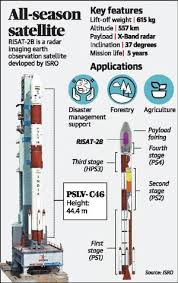Why in news?
The RISAT-2B satellite was launched with the PSLV-C46 by the Indian Space Research Organisation (ISRO).
What is the RISAT?
- Two satellites in RISAT (radar imaging satellite) series have earlier been launched by ISRO.
- RISAT-2 was the first one to be launched, in 2009, while RISAT-1, which had got delayed, was launched only in 2012.
- RISAT-1 is no longer operational.
- After a very long time, ISRO’s PSLV rocket was used to launch just one satellite into space.
- In recent times, ISRO has been launching multiple satellites at one go.

What are the key features?
- The RISAT, or radar imaging satellite, is equipped with a sensor known as ‘synthetic aperture radar’, to take "radar images".
- It works much like the flashlights of a camera, which release visible light to illuminate an object and then use the reflected light to create an image.
- The synthetic aperture radar transmits hundreds of radio signals (microwave pulses) every second towards the ground.
- It then captures the signals reflected back by the objects, to create a radio image, which can then be used by computers to build a real image.
- The moisture and texture of the object will determine the strength of the microwave signal that gets reflected.
- The strength of the reflected signal will help determine different targets.
- Likewise, the time between the transmitted and reflected signals will help determine the distance to the object.
- Unlike visible light, microwaves have longer wavelength and so will not be susceptible to atmospheric scattering.
- In other words, the very large wavelength radio waves are not obstructed by clouds, dust or other such obstacles in the atmosphere.
- So they produce reliable images during day and night and all seasons.
- The RISAT-2B satellite uses X-band synthetic aperture radar for the first time, which was developed indigenously.
- Unlike the C-band that was used by RISAT-1, the X-band allows for higher resolution imagery for target identification and discrimination.
- [C-band and X-band are the designations for a band of frequencies in the microwave radio region of the electromagnetic spectrum.]
- Since it has high resolution, the satellite will be able to detect objects with dimensions of as little as a metre.
- This capacity to study small objects and also movement could be useful for surveillance.
What is the significance?
- RISAT-2B adds to India’s capability to observe the earth in all weathers and all conditions.
- It will enhance India’s monitoring capabilities for civil and military purposes, which include -
- crop monitoring during the monsoon season
- forestry mapping for forest fires and deforestation
- flood mapping as part of the national disaster management programme
- Given that overcast skies are a constant during monsoon season and times of flood, the ability to penetrate the cloud cover is essential.
- While optical remote sensing that relies on visible light for imaging gets obstructed by clouds, RISAT-2B will not.
- Services of such satellites are in great demand from national security agencies as well.
Source: Indian Express, The Hindu
